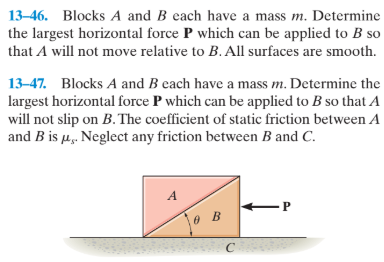13–46. Blocks A and B each have a mass m. Determine the largest horizontal force P which can be applied to B so that A will not move relative to B. All surfaces are smooth. 13-47. Blocks A and B each have a mass m. Determine the largest horizontal force P which can be applied to B so that A will not slip on B. The coefficient of static friction between A and B is u. Neglect any friction between B and C.
13–46. Blocks A and B each have a mass m. Determine the largest horizontal force P which can be applied to B so that A will not move relative to B. All surfaces are smooth. 13-47. Blocks A and B each have a mass m. Determine the largest horizontal force P which can be applied to B so that A will not slip on B. The coefficient of static friction between A and B is u. Neglect any friction between B and C.
International Edition---engineering Mechanics: Statics, 4th Edition
4th Edition
ISBN:9781305501607
Author:Andrew Pytel And Jaan Kiusalaas
Publisher:Andrew Pytel And Jaan Kiusalaas
Chapter7: Dry Friction
Section: Chapter Questions
Problem 7.71P: The 600-lb cable spool is placed on a frictionless spindle that has been driven into the ground. If...
Related questions
Question

Transcribed Image Text:13–46. Blocks A and B each have a mass m. Determine
the largest horizontal force P which can be applied to B so
that A will not move relative to B. All surfaces are smooth.
13-47. Blocks A and B each have a mass m. Determine the
largest horizontal force P which can be applied to B so that A
will not slip on B. The coefficient of static friction between A
and B is u. Neglect any friction between B and C.
Expert Solution
This question has been solved!
Explore an expertly crafted, step-by-step solution for a thorough understanding of key concepts.
This is a popular solution!
Trending now
This is a popular solution!
Step by step
Solved in 7 steps with 4 images

Recommended textbooks for you

International Edition---engineering Mechanics: St…
Mechanical Engineering
ISBN:
9781305501607
Author:
Andrew Pytel And Jaan Kiusalaas
Publisher:
CENGAGE L

International Edition---engineering Mechanics: St…
Mechanical Engineering
ISBN:
9781305501607
Author:
Andrew Pytel And Jaan Kiusalaas
Publisher:
CENGAGE L